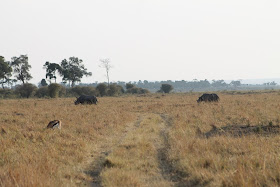Wake
Obs 5:30 am
– 9:00 am
Breakfast
Write up
transcriptions and complete chores
Personal
time, dinner if you are in Serena
Obs 5:00 pm
– 8:30 pm
Dinner if
you are in Talek
Bed
Wildlife
The Masai Mara has been referred to as the jewel of the Africa’s game parks for good reason. The large savannas and array of micro-ecosystems supported by two rainy seasons allows for an abundance and diversity of wildlife that is unrivaled in most of the continent. This is one of the many reasons why tourists and research teams, like ourselves, the Mara Lion Project, the Mara Cheetah Project, and the Mara Water project flock to the area. (Though, we have certainly been here the longest at 28 years!!) It is also something that provides research assistants, graduate students, and even professors memories that last a lifetime.
 |
| Elands (Taurotragus oryx) Elands are normally very shy, and will bolt when trucks like ours come near. This beautiful individual calmly fed within 10 m of my truck without showing any urge to run. |
 |
| Black Rhinos (Diceros bicornis) Its rare for us to encounter rhinos, even though we are out daily. We do our best to let park managers know how often we sight them for population measures |
 |
| Elephants (Loxodonta africana) These animals are as majestic as they are intimidating. I've always preferred to see them along the horizon, rather than outside my tent in the dark. |
 |
| Wildebeest (Connochaetes taurinus) At this point in the season its next to impossible to miss these. The great migration season is starting to trail off, but we still count thousands of them monthly |
Sunrises and Sunsets
Sunsets and sunrises in the Mara remind me so much of the skies in my home state of New Mexico that my first blog this year was dedicated to the comparison. It is no surprise that the Mara and New Mexico seem so similar, as they share comparable elevations, can both be quite arid at times, are both results of geologically recent volcanic rifts and eruptions, and at one point even shared comparable fauna. Of course, to know this about the American southwest one would have to look at fossil records. We once had American cheetahs, mastodons, and many other species you would expect to see on an East African grassland (but never any bone-cracking hyaenids!). Many of these species went extinct not long ago due to changing climates, and competition with early humans. This connection between the two systems is always brought back to me when I watch the skies, reminding me how fragile this ecosystem is.
 |
| This shot was taken while I was having a nice sit with the oldest hyena on record, Navajo. She will be turning 24 this November, and is still going strong. |
 |
| I had just finished my morning coffee while observing cub behavior when I turned to this seen. The wildebeest were apparently unaware that there were 20 hyenas denning here. |
New Life
Due to the nature of my research I am able to spend a great deal of time with young animals as they mature. This means every morning and evening in the field I seek out situations were cubs are playing, nursing, learning and generally being extremely cute. It's what gets me out of bed each morning, even when I've earned a morning in, and what keeps me out late enough that I have to set an alarm so that I leave the den in time to make it to camp for curfew. [The rangers in Serena like us to be back close to 8 pm, because they are tracking poachers, and don't want to accidentally track us]. This means hours of comedic and cute antics of cubs, sub-adults that want to play with the cubs, and mothers either playing or being annoyed by the activity at the den.
 |
| This is either Lake Toba (TOBA) or Kapuas River (KAPU), twins of JAVA The twins are three weeks old here, but they still don't have distinct markings to tell them apart yet |
 |
| Every once in a while cubs just want to cuddle with their mom and nurse. Grace O'Malley (OMLY) had an exhausting morning playing before curling up with mom |
 |
| Not a hyena! We recently found an area in our territory where some black backed jackals a denning The pups are getting old enough now that they are learning to hunt, and are fun to observe. |
I hope this photo journey helped you see what we see, and understand why we do what we do. I encourage you to come out to the Mara to see these wonders for yourself. If you want to learn more about conservation of this area please check out the websites below.





No comments:
Post a Comment